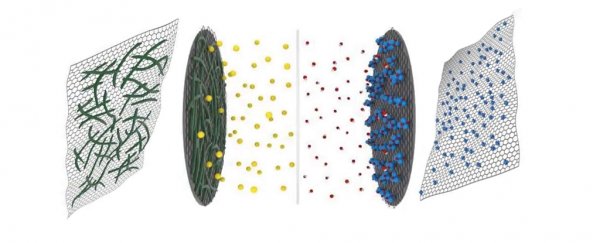A novel approach to an energy storage device run on an aqueous electrolyte can go from flat to fully-charged in just 20 seconds, making it perfect for portable electronics that frequently need a quick boost.
While the concept isn't new, previous attempts have resulted in devices that suffer from low power and short working lives.
We ask a lot of power storage tech these days. Not only must it be compact, powerful, long-lasting, and quick to recharge, it also has to be environmentally friendly. Oh, and preferably not blow up if you happen to chew on it.
For those and other reasons, aqueous storage devices – those that contain water-based solutions rather than a mush of toxic or flammable organic paste – have gained some serious attention as safe and reliable options.
Although less flammable than modern lithium batteries and potentially a whole lot cheaper, the way the solution carries electrons introduces a serious problem.
The cells that make up a battery work by transferring electrons between two materials. Aqueous solutions limit the voltage range between the two points more than other solutions, resulting in the anode being eaten away faster.
That makes for a poor life span and low amounts of power – not exactly great for reliably pushing your latest smart device through the day.
So researchers at Korea Advanced Institute of Science and Technology (KAIST) have put a new spin on the system, modifying the way a device called an aqueous hybrid capacitor (AHC) is constructed.
Hybrid capacitors such as these are essentially a mix of battery and capacitor – with electrodes that store their power electrochemically as an electrostatic charge. Adding an aqueous solution of ions inbetween can help carry the current.
By using graphene-based polymers instead of more traditional metallic conductors on the anode, and making the cathode with a scattering of metaloxide nanoparticles, the researchers were able to overcome the shortfalls of previous AHCs.
The web of tiny carbon fibres on the anode turns out to be far more efficient at transferring electrons into the aqueous solution, allowing for batteries with more than 100 times the power density than previous devices while still sustaining capacity for over 100,000 charges.
Better yet, the new anodes coupled with liquid electrolytes mean the whole thing can go from zero to 100 perfect with just 20 seconds of charging.
All of this is at no cost to its safety or economics.
"This eco-friendly technology can be easily manufactured and is highly applicable," says chemist Jeung Ku Kang.
"In particular, its high capacity and high stability, compared to existing technologies, could contribute to the commercialization of aqueous capacitors."
Since the power source doesn't need to be a strong one, its rapid rate of charging might see it couple up neatly with photovoltaic cells or other micro-generating power sources.
It'll be a while before we see these kinds of devices outcompete the likes of lithium ion batteries, but cheap cells that can handle extreme conditions without catching fire will no doubt find a place in future portable technology.
The low charge time is just an added bonus, though we've been promised charge-while-you-wait batteries for years now.
The wonder-material graphene is keeping our hopes alive, with Samsung exploring its potential in materials that might see a smart phone being fully loaded with power in about 12 minutes.
Beefed up capacitors could provide an altogether different approach, allowing us to charge up in less time than it takes to say "I'm on 1 percent I'll call you right back!"
Who knows where quick-charge aqueous batteries will fit among these kinds of storage technologies. But given the rate at which cheap, power-hungry smart devices are spreading, we're going to need more like them.
This research was published in Advanced Energy Materials.
